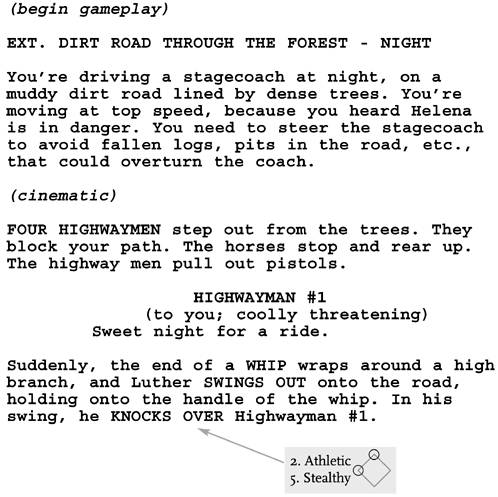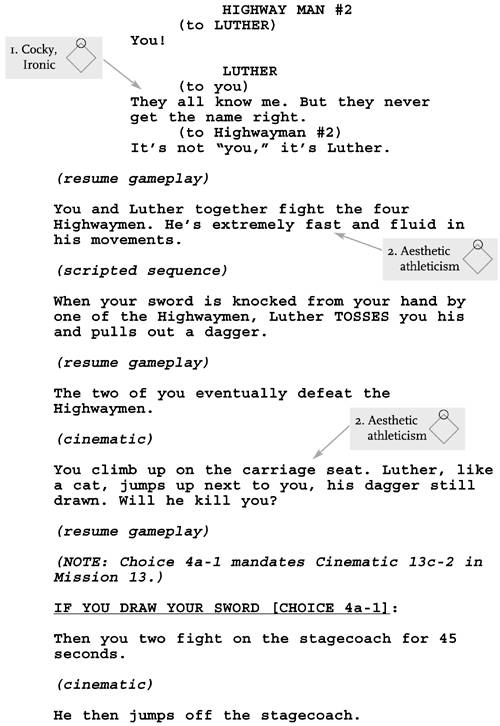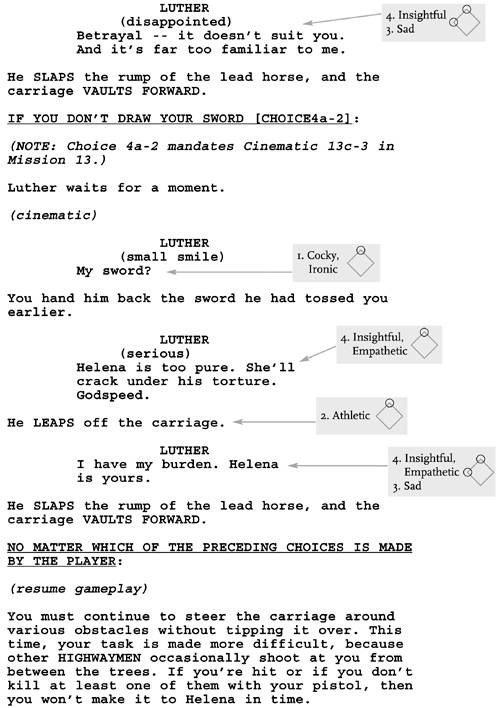The Hypothetical Game
|
Clearing Up Some Possible MisunderstandingsThe idea of creating Character Diamonds seems easy. Yet, in one of my most recent screenwriting classes, most of students struggled to create interesting Diamonds. Here are few guidelines:
Artful or Arbitrary?"If all you need is a colorful grouping of Traits to make an interesting major NPC," one game designer asked me, "then why not put a list of Traits up on the wall and throw darts? Whichever three, four, or five Traits the darts hit, you could use for a Diamond." He might be right; this could potentially create an interesting character. I doubt, though, that random chance would create a useful character for your game. Picking the Traits is where the art comes in. Many factors might weigh in on the selection, but ultimately it's up to the person who creates the character to make the difficult choices. I can teach craft; I can't teach art. This is exactly why I and so many other professional writers study the work of writers we admire: to examine what choices they made and to try to discern the thinking behind those choices. Personally, I give very serious consideration to the Traits I pick when creating a major NPC's Diamond. Sometimes I use a list of several thousand Traits I've assembled to help spark ideas. I deliberate on the choices, because I, the other designers, and ultimately the players are going to have to live with these characters for a long time. "Traits" Versus "Quirks"Let's go back to that NPC who trips a lot. I've already mentioned that tripping over things wouldn't be a Trait. Tripping frequently would be a "quirk." A quirk is something that gives individuality to an NPC without being as important as a Trait. By using the word "quirk," I don't mean that the behavior needs to be extreme or odd. It's merely something less important than a Trait. If an NPC likes jazz, that's also a quirk. It doesn't measure up to the importance of a Trait. Quirks are another way of making NPCs interesting. Minor NPCsMinor NPCs don't need three or more Traits. Two, or even one, can be sufficient. At a minimum, these Traits need to be interesting and unexpected for such a character. If the NPC has two Traits, at least one needs to be interesting and unexpected. For example: You lead a platoon, and one soldier is always depressed, but in a slightly funny way. He has just one Trait Depressed in a Funny Way but it's interesting. You could argue that this is two Traits: Depressed and Funny. That would be true, if he was funny on a regular basis. If the funniness is just part of his depression and doesn't emerge anywhere else, then it's simply a modifier of Depressed. Modifying Traits is fine. Just try to be clear to yourself whether you're modifying one Trait or adding a second one. Either case is fine; it's just helpful to know exactly what you're doing. Or let's say you have an air traffic controller in your flight sim (simulation) game. He's a minor NPC. Give him two Traits, such as Sarcastic and Easily Excited, and have a sufficiently interesting character. Let's go back to our soldier who was Depressed in a Funny Way. Could you give him just one Trait (Depressed)? Sure, and he could still be interesting. But the key there would be to make sure that his dialogue isn't a cliché. (See Chapter 2.3, "Dialogue Interesting Techniques.") "But Game Players Like Cliché Characters."I've been given this line more than once by game designers and publishers. The thinking goes like this: If the NPC is a clichè such as a "mafia type," then the player can instantly figure out "who the character is." My argument is always the same: If people hate clichés in films and they hate clichés in television, then I refuse to believe that the minute they start playing a game, all their standards change and they're suddenly overcome by inexplicable longings for rehashed characters and formulaic dialogue. |
EAN: 2147483647
Pages: 394
- Key #3: Work Together for Maximum Gain
- Key #4: Base Decisions on Data and Facts
- Beyond the Basics: The Five Laws of Lean Six Sigma
- Making Improvements That Last: An Illustrated Guide to DMAIC and the Lean Six Sigma Toolkit
- The Experience of Making Improvements: What Its Like to Work on Lean Six Sigma Projects


